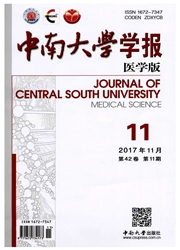

 中文摘要:
中文摘要:
目的:探讨黄连素(berberine,BBR)抑制鼻咽癌细胞侵袭及移动的分子机制,明确BBR是否通过抑制Ezrin蛋白抑制鼻咽癌侵袭转移。方法:采用细胞增殖实验(MTT)测定BBR非毒性浓度(non-cytotoxicconcentration,NCC),扫描电子显微镜观察BBR在NCC对鼻咽癌细胞5-8F细胞伪足形成的影响,Trans-well实验检测BBR处理后鼻咽癌细胞运动侵袭能力;Western印迹检测BBR对鼻咽癌细胞Ezrin蛋白表达及其磷酸化(phos-Ezrin)的影响;基因转染技术将pcDNA3.1-Ezrin和pcDNA3.1-Ezrin M转染至6-10B细胞,分析BBR对上述细胞运动能力的影响。结果:BBR的NCC为0~40μmol/L;BBR在此浓度范围能有效地抑制细胞伪足形成,抑制鼻咽癌细胞5-8F穿过人工基底膜,与对照组比较,差异有统计学意义(P〈0.05),并具有浓度依赖性和时间依赖性;BBR抑制5-8F细胞phos-Ezrin表达且呈浓度依赖性和时间依赖性,与对照组比较,差异有统计学意义(P〈0.05);BBR对6-10B-pcDNA3.1-Ezrin M侵袭移动抑制作用弱于6-10B-pcDNA3.1-Ezrin。结论:BBR可以通过抑制Ezrin磷酸化表达和细胞伪足形成阻断鼻咽癌细胞的转移。
 英文摘要:
英文摘要:
Objective To determine the molecular mechanism of berberine(BBR) inhibiting the metastasis and invasion of nasopharyngeal carcinoma 5-8F cells,and identify whether berberine suppresses the tumor-invasive action through inhibiting Ezrin or phosphate-Ezrin.Methods The non-cytotoxic concentration of berberine was detected by MTT assay.Filopodia formation of 5-8F cells was observed by electron microscope.The invasion and motility of 5-8F cells with berberine treatment were measured with Trans-well assay.Western blot was used to investigate the Ezrin and phos-Ezrin expression in 5-8F cells treated by berberine.pcDNA3.1-Ezrin and pcDNA3.1-Ezrin M were transfected into 6-10B cells.The inhibitory effect of berberine on the motility and invasion of 6-10B-pcDNA3.1-Ezrin and 6-10B-pcDNA3.1-Ezrin M was detected,respectively.Results Berberine non-cytotoxic concentration was 0-40 μmol/L.After being treated by berberine,filopodia of 5-8F cells obviously reduced,and the permeating artificial basement membrane cells largely decreased in both time-and concentration-dependent manner.There was significant difference compared with the control group(P0.05).Berberine suppressed the phos-Ezrin expression of 5-8F cells in both time-and concentration-dependent manner(P0.05),but the effect of berberine was weaker on 6-10B-pcDNA3.1-Ezrin M than on 6-10B-pcDNA3.1-Ezrin.Conclusion Berberine inhibits nasopharyngeal carcinoma cell invasion through inhibiting phos-Ezrin expression and filopodia formation.
 同期刊论文项目
同期刊论文项目
 同项目期刊论文
同项目期刊论文
 N,N'-Dinitrosopiperazine-mediated Ezrin Protein Phosphorylation via Activation of Rho Kinase and Pro
N,N'-Dinitrosopiperazine-mediated Ezrin Protein Phosphorylation via Activation of Rho Kinase and Pro Proteomic analysis on N,N-dinitrosopiperazine -mediated metastasis of nasopharyngeal carcinoma 6-10B
Proteomic analysis on N,N-dinitrosopiperazine -mediated metastasis of nasopharyngeal carcinoma 6-10B Baicalein mediates inhibition of motility and invasiveness of skin carcinoma through Ezrin in A431 c
Baicalein mediates inhibition of motility and invasiveness of skin carcinoma through Ezrin in A431 c N,N '-Dinitrosopiperazine-mediated Ezrin Protein Phosphorylation via Activation of Rho Kinase and Pr
N,N '-Dinitrosopiperazine-mediated Ezrin Protein Phosphorylation via Activation of Rho Kinase and Pr 期刊信息
期刊信息
